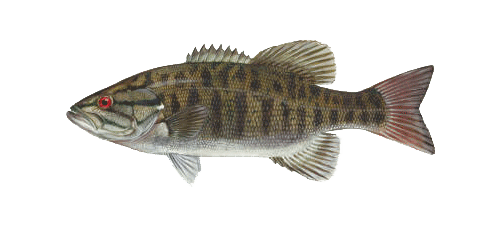
Scientific name:
Micropterus dolomieu (Micropterus means "small fin"; dolomieu was named after M. Dolomieu, a French mineralogist.
Identification:
Back and head brown, or yellow-brown, or olive to green; sides lighter; belly light yellow to white. Most scales on sides with bronze reflections. Vertical bars faint, 9-16 (generally more numerous and prominent in young), not fused into a lateral band. Usually 3 dark streaks on each side of head, radiating back- ward from snout and eye; dark opercle spot about size of pupil of eye. Eye usually red or orange. Fins lightly pigmented, caudal fin in adults with darker edge; in young, caudal fin strikingly marked with yellow at base, pronounced dark crescent band through middle, and a whitish edge.
Distribution:
The smallmouth bass occurs in all three drainage basins in Wisconsin (Lake Michigan, Mississippi River, and Lake Superior). It is quite probable that the fish was distributed over the state approximately as it is at present before any introductions were made. The smallmouth bass is common in medium to large streams and in large, clearwater lakes throughout Wisconsin.
Spawning:
In Wisconsin, smallmouth bass spawning usually occurs at water temperatures between 62 - 64º F, but they have been found spawning at 53º F. In southern Wisconsin, the smallmouth spawns from the middle of May through June (water temperatures between 55 - 75º F). The male smallmouth may build several "practice nests" until he finally settles on one as suitable. The nest is usually a large, perfectly circular, clean gravel structure. The male bass protects the nest against intruders of his own and other species.
Angling:
Pound for pound the smallmouth bass is the scrappiest fish of all Wisconsin. It is usually associated with a rocky stream or lake environment where its favorite food, the crayfish, is abundant. Some of the best lake fishing takes place in June during, and just after, the spawning season, and in early fall. Natural baits like hellgrammites, dragonfly larvae and crayfish are especially effective during early morning or late evening. (Note: In Wisconsin it is illegal to possess live crayfish while fishing or while possessing angling equipment on any inland water, except the Mississippi River.) Probably the best artificial baits are those used on the surface. Light tackle is ideal. Fish quietly, casting toward rocks or logs, keeping the rod tip up and the line taut.